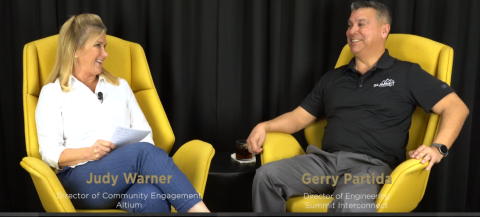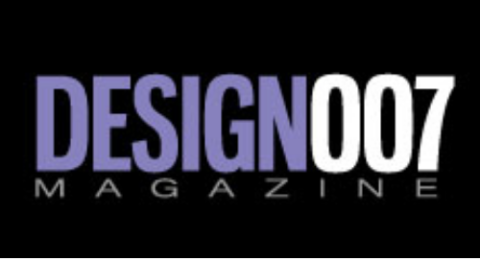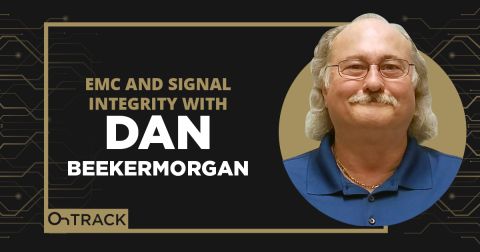OnTrack Podcast 2022 Year in Review

Join us as we reflect on the best moments and the coolest guests we've had on the OnTrack podcast this year. 2022 has been a whirlwind year for the electronics industry–chip shortages, and a supply chain crunch. Altium has passed several milestones, as well as releasing an education program. And there have been some groundbreaking reports from industry groups highlighting the need for workforce training and development, and workforce shortages coming on the horizon.
Listen to Podcast:
Download this episode (right-click and save)
Watch the Video:
Show Highlights:
- One of Altium’s Milestone is the Altium Education Program
- In most of the episodes, the issue of automotive chips shortage comes up coupled with the passing of the PCB Act
- IC Packaging, and production of integrated circuit substrates
- Most requested repeat guests and new faces
Links and Resources:
- Watch all the OnTrack Podcast Episode
- Register at Altium Education for Free
- Connect with Zach on LinkedIn
- Visit Nexar website
- Visit Octopart website
Claim the special offer for Podcast listeners only
Zach Peterson:
- Hello everybody, and welcome to our 2022 year end review for the Altium OnTrack podcast. I am your host, Zach Peterson and today we're gonna go over some of our best moments and our coolest guests we've had on the podcast this year. This year has been a whirlwind year for the electronics industry. We've had chip shortages, a supply chain crunch. Altium has passed several milestones, as well as releasing an education program. And there have been some groundbreaking reports from industry groups highlighting the need for workforce training and development, workforce shortages coming on the horizon. And of course supply chain problems abound going into the future. First we had the release of the Altium education program. We talked with several folks from academia and industry all working to train the next generation of PCB designers.
Rea Callender:
- Yeah, we've been talking to college professors and showing them exactly, you know, what we have. And we've gotten an excellent response. And it's interesting that, you know, despite the fact that we know how important printed circuit boards are, despite the fact that we know that the talent pool is reducing, a lot of colleges don't offer courses on print circuit board design.
Sid Deliwala:
- In electrical and computer engineering we are the experts on the interface, so we should be the one who should lead this data revolution.
Zach Peterson:
- I think maybe we're just a little too risk averse in this industry sometimes.
Chris Bonsell:
- Yeah, I haven't really heard too many cases where a printed circuit board company was trying to take a little bit more of a risk in their etching chemistry, just so they can get slightly better, you know, sidewall etching.
Zach Peterson:
- You know, it really sounds like there's a lot of room for growth for young people coming into this industry.
Paige Fiet:
- Yeah, and I think that's one of the most exciting parts, right? Is that you get to become the new subject matter expert in whatever topic you wanna learn, because those people are gonna be retiring in the next 5, 10 years.
Zach Peterson:
- What does the background for students look like?
Andrew Hartnett:
- Man, it can be all over the place. You know, we've had some students that have come in and maybe through hobbies or possibly through classes they've already done some schematic design or PCB layout. I couldn't tell you how a transistor worked when I joined.
Zach Peterson:
- If there's one story you saw repeatedly on the news in 2022 it was all about the automotive chip shortage. There was a major semiconductor shortage due to shutdowns overseas. And of course, this led to passage of the CHIPS and Science Act. It also led to the introduction of the PCB Act in the US House of Representatives. We talked to folks from industry and government to get some insight into what this means for the semiconductor industry and for the PCB industry. Come check it out.
Travis Kelly:
- So you're spot on, Zach, and you know, my kids, when they think about technology, it's cybersecurity it's NVIDIA, it's Chips, it's the big software. You know, no one really thinks, you know, I say that our industry is not overly sexy, but it's absolutely critical.
Zach Peterson:
- So is there an objectively best number, or market share for American printed circuit boards?
Blake Moore:
- More. If we were at 25%, that would be a huge, huge win in my opinion, to get us back to that.
Chris Cain:
- You have to ask yourself the question, is that choice of microprocessor in its development toolkit, is that really core to me delivering value in my design? That's what I love about thinking about supply chain. I view it as a way to maximize the return on my investments.
John Mitchell:
- I don't expect the entire supply chain to exist in Europe, the entire supply chain to exist in North America, the entire supply chain exist in Asia. I don't expect that at all. I expect there to be pieces of it in, you know, in those places and key pieces of it.
Rob Spalding:
- So over time, TSMC has built themselves, you know, up to be the best Chip company in the world, because they own the manufacturing line. And I think it was coming from China, and the supply chain's broken.
Greg Papandrew:
- When I actually broached the subject on it it's a million pieces a year. I was saving them 40 cents per board on this. And they said, Greg, why are you pushing this so much? I said, well, I'll stop but I'm giving you 400,000 reasons a year why you should redesign this board. You know? And so that's where I really help when I look at stuff, hey, do we have to have this kind of technology? Is that a question? And in some cases, yes, we do.
Zach Peterson:
- Following passage of the CHIPS and Science Act, the conversation shifted away from semiconductor production and into packaging and specifically into production of integrated circuit substrates. These components are a critical piece of the semiconductor supply chain. And currently North America lacks the manufacturing capacity that it needs to ensure sustainable production of semiconductors and of course, all of the products we all enjoy. We talked to some new guests from the packaging industry and learned what this means for PCB designers.
John Mitchell:
- Right now, there's a lot of focus, as you mentioned on semiconductors. And the advanced version of PCBs is advanced packaging, you know, IC substrate OSAP type of capability. And that's really lacking in this country.
Geoffrey Leeds:
- You know, five minutes on Google and you'll find tons of papers from 2000 to 2003 where the packaging industry was dealing with Micro-V reliability issues way back then. And it's almost comical how similar our conversations were today as they are being discussed in these papers. But materials behave differently based on how we process them.
Joe Dickson:
- The question's always gonna be, when do we leave copper? When do we go to optical? The question isn't anymore, are we going to optical? It's how far can we go with copper before we have to go to optical? I think that is exactly where it's gonna go. The evolution. And we haven't even touched on power, which is a whole nother, probably a whole nother conversation.
Joseph Fjeldstat:
- Rather than building a circuit board and putting components on it, build a component board and put circuits on it. And with the work that we had done at chip scale packaging it all suddenly, you know, made sense. You know, there are a billion different packages out there and probably almost as many formats, if you will.
Matt Kelly:
- Where we're actually putting various levels of technology, different chip nodes closer together on a single chip system and package system on a chip, those kinds of things. And there's a lot of functional benefits that are coming with that. But on the product side, you know, you don't have to look very far other than the cell phone on your desk where we're really just talking about increased functionality. We're trying to put so many different functions into single devices. Couple that with miniaturization and all these other forces, you know, there's really a good, you know, three or four things that are all happening here, which is really the reason why architecture of Chiplet design is really now starting to take hold.
Zach Peterson:
- And last but not least, we had some familiar faces come on the podcast from some of your favorite Altium live sessions, as well as past episodes with Judy Warner. And we had some new faces that we hope you will all get to know.
Ian Hillier:
- Oxy Propane torch. So yeah, so you hook it up to...
Zach Peterson:
- Can we fire it up on video?
Ian Hillier:
- I can't right now. I have the fuel tanks over here right now, but they're empty and my office is a little flammable.
Heidi Barnes:
- Of course, if I put a bead in there, it kills the high frequency. But they completely missed the point that I have a digital load that needs power at high frequencies. So, now what do I do? I just killed my ability to deliver power at high frequencies. And now I've got a bit, sort of a bigger challenge on delivering or designing my decoupling capacitors. And I think that's the one that people miss. You can use the bead, but most people completely fail to adapt their power, their decoupling capacitors to work nicely with that bead.
GreatScott:
- As you can see, I recently did a PCB so I do it more often now, but back in the days when I was kind of afraid to making PCBs, designing them, because I had no idea how it works. I did not use it only because the circuit was too big.
Dr. Min Zhang:
- I think this is a really, really good discussion Zach, because what we just did was actually trying to explain a phenomenon from both sides. So when I say both sides, we all know that loss of engineers are more comfortable with lumped circuit element analysis. That's the way loss of RF engineers and high speed circuit designers think. And I really appreciate it because as we just discussed at the very beginning I think understanding the first principle, understanding the basics, is really, really important when it comes to EMI problem solving and CP design.
Zach Peterson:
- I mean, I don't think we should be comparing ourselves 'cause I see some of your stuff is an hour long, you know?
Phil Salmony:
- Oh gosh, yeah. I dunno why people even bother watching that. But yeah.
Zach Peterson:
- So I mean, you're going deep on some of these topics. Well, you know it gets bad when people start buying the eval boards or the dev boards and desoldering the ICs.
Phil Salmony:
- Oh gosh.
Zach Peterson:
- Just so they can get access to chips.
Phil Salmony:
- Yes, that is grim. I mean, the thought did cross my mind and I was like, no way I am doing that.
Zach Peterson:
- Thanks to everyone who subscribed and watched the Altium OnTrack podcast throughout 2022. Make sure to stick with us through 2023 as we continue these conversations in these important areas affecting the electronics industry. As we always say, don't stop learning, stay on track and we'll see you next time.










